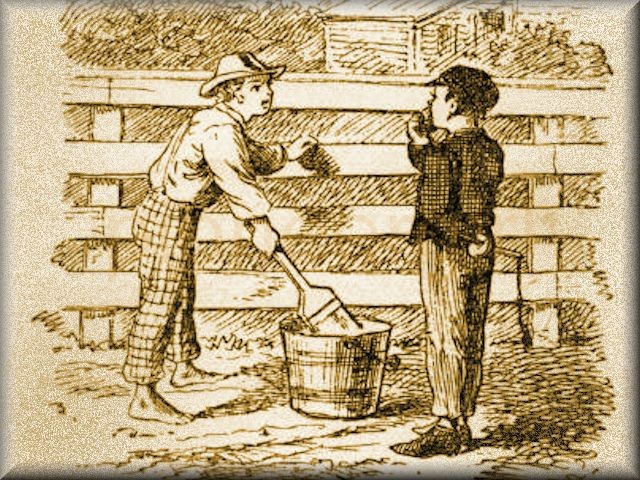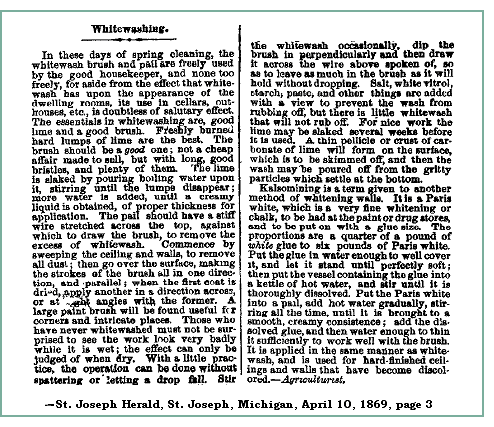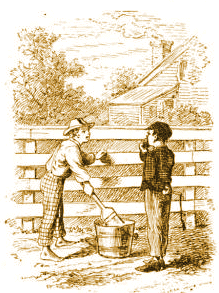lime / whitewash

Lime – Oxide of calcium; the white, caustic substance, usually called quicklime, obtained from limestone, shells, &c., by heat, the heating expelling carbonic acid, and leaving behind the lime. — Webster, 1882
Whitewash – A composition of lime and water, or of whiting, size, and water, used for whitening the plaster of walls, and the like. — Webster, 1882
 Tom resumed his whitewashing, and answered carelessly: ‘Well, maybe it is, and maybe it ain’t. All I know is, it suits Tom Sawyer.’ – Mark Twain, The Adventures of Tom Sawyer
Tom resumed his whitewashing, and answered carelessly: ‘Well, maybe it is, and maybe it ain’t. All I know is, it suits Tom Sawyer.’ – Mark Twain, The Adventures of Tom Sawyer
 In the nineteenth century, whitewash was commonly used to whiten plaster walls, boards, and masonry. It is not a paint, but a medium that soaks into existing plaster or other finishes and allows both air and moisture to pass through it. In Farmer Boy, the Wilders’ cellar had whitewashed walls, and both the interior of the Plum Creek dugout and Mr. Nelson’s house in On the Banks of Plum Creek were whitewashed.
In the nineteenth century, whitewash was commonly used to whiten plaster walls, boards, and masonry. It is not a paint, but a medium that soaks into existing plaster or other finishes and allows both air and moisture to pass through it. In Farmer Boy, the Wilders’ cellar had whitewashed walls, and both the interior of the Plum Creek dugout and Mr. Nelson’s house in On the Banks of Plum Creek were whitewashed.
In 1868, when the Surveyors’ House in De Smet, South Dakota, was being renovated by the Laura Ingalls Wilder Memorial Society, interior wallpaper and plaster was removed from the original walls, exposing the backs of wide boards used on the exterior. Traces of the original treatment – whitewash – were exposed. It took some time for Society members to figure out what the original treatment had been, first ruling out paint or calcimine. A white-washing bee was held to give the boards a coating of their original white covering. You can read about calcimine and whitewash in the article shown.
Whitewash is made by stirring water into lime. Lime is a powder produced when limestone or burned shells are combined with water in a process called slaking. The pails of lime that Royal Wilder added water to are said to boil; much heat is produced when lime and water are combined. Whitewash is usually applied in multiple layers with a wide, flat brush. When nearly dry, it is buffed with a rag or dry brush to create a smooth finish.
Lime.
Lime for whitewash was produced by burning shells – particularly oyster shells – for about twelve hours in a very hot fire, causing them to become very brittle. The heat also changes the chemical composition of the shells. Oyster shells are largely made up of calcium carbonate (CaCO3). Heat causes some of the carbon (C) and oxygen (O) to escape as carbon dioxide (CO2). The remaining calcium (Ca) and oxygen (O) form quicklime (CaO), so named because when mixed with water, it reacts very quickly, even to the point of exploding violently.
Whitewash.
Take a clean, water-tight cask and put into it half a bushel of lime. Slake it by pouring water over it in sufficient quantity to cover it five inches deep, and stir it briskly till thoroughly slackened. When the lime has been slacked, dissolve it in water, and add two pounds of sulphate of zinc and one of common salt. These will cause the wash to harden and prevent its cracking, which gives an unseemly appearance to the work. A beautiful cream color may be given to the wash by adding three pounds of yellow ochre; or a good pearl or lead color, by the addition of lamp or iron black. For fawn color add four pounds umber, one pound Indian red, and one pound common lamp black. For stone color add four pounds raw umber and two pounds lamp black. When applied to the outside of houses and to fences, it is rendered more durable by adding about a pint of sweet milk to a gallon of wash. — Simon Brown and Stilman Fletcher, editors, The New England Farmer (Boston: R.P. Eaton & Company, 1868), 47.
Whitewash that will not wash off. Mix up half a pailful of lime and water; take half a pint of flour and make a starch out of it, and pour it into the whitewash while hot. Stir it well, and make it ready for use. — Godey’s Lady’s Book and Magazine (March 1870), 379.
 One of the most well-known stories involving whitewash is found in Mark Twain’s The Adventures of Tom Sawyer. In the story, young Tom laments having to whitewash Aunt Polly’s fence, which he imagines to be “nine feet high and thirty yards long.” Tom comes up with the ingenious idea to pretend that the work is so much fun that the other boys want nothing more than to help him at his job. Perhaps Laura Ingalls Wilder thought about Mark Twain’s story when writing Almanzo’s own, and surely she experienced some of the same frustrations over her book being treated as a “boy’s book” that Twain did.
One of the most well-known stories involving whitewash is found in Mark Twain’s The Adventures of Tom Sawyer. In the story, young Tom laments having to whitewash Aunt Polly’s fence, which he imagines to be “nine feet high and thirty yards long.” Tom comes up with the ingenious idea to pretend that the work is so much fun that the other boys want nothing more than to help him at his job. Perhaps Laura Ingalls Wilder thought about Mark Twain’s story when writing Almanzo’s own, and surely she experienced some of the same frustrations over her book being treated as a “boy’s book” that Twain did.
The Adventures of Tom Sawyer was written during several periods in the years 1872-1875. It was published in the United States in 1876, but was poorly promoted and received. When pirated copies appeared on the American market, Twain was discouraged as a writer, and didn’t publish a book for five years. Sales for Tom Sawyer didn’t improve until after 1885, when Twain’s Huckleberry Finn appeared with the subtitle Tom Sawyer’s Comrade.
The following is taken from Chapter 2 of The Adventures of Tom Sawyer by Mark Twain. The illustration is titled “Ain’t That Work?” and was drawn by True Williams for the 1885 edition, published in London by Chato & Windus:
Tom appeared on the side-walk with a bucket of whitewash and a long-handled brush. He surveyed the fence, and all gladness left him, and a deep melancholy settled down upon his spirit. Thirty yards of board-fence nine feet high! Life to him seemed hollow, and existence but a burden. Sighing he dipped his brush and passed it along the topmost plank; repeated the operation; did it again; compared the insignificant whitewashed streak with the far-reaching continent of unwhitewashed fence, and sat down on a tree-box discouraged…
…He began to think of the fun he had planned for this day, and his sorrows multiplied. Soon the free boys would come tripping along on all sorts of delicious expeditions, and they would make a world of fun of him for having to work–the very thought of it burned him like fire. He got out his worldly wealth and examined it–bits of toys, marbles, and trash; enough to buy an exchange of work, maybe, but not half enough to buy so much as half an hour of pure freedom. So he returned his straitened means to his pocket, and gave up the idea of trying to buy the boys. At this dark and hopeless moment an inspiration burst upon him! Nothing less than a great, magnificent inspiration.
He took up his brush and went tranquilly to work. Ben Rogers hove in sight presently–the very boy, of all boys, whose ridicule he had been dreading. Ben’s gait was the hop-skip-and-jump–proof enough that his heart was light and his anticipations high. He was eating an apple, and giving a long, melodious whoop at intervals, followed by a deep-toned ding-dong-dong, ding-dong-dong, for he was personating a steamboat…
…Tom went on whitewashing–paid no attention to the steamboat. Ben stared a moment, and then said:
‘Hi-yi! You’re up a stump, ain’t you?’
No answer. Tom surveyed his last touch with the eye of an artist; then he gave his brush another gentle sweep, and surveyed the result, as before. Ben ranged up alongside of him. Tom’s mouth watered for the apple, but he stuck to his work. Ben said:
‘Hello, old chap; you got to work, hey?’
Tom wheeled suddenly and said: ‘Why, it’s you, Ben! I warn’t noticing.’
‘Say–I’m going in a-swimming, I am. Don’t you wish you could? But of course you’d druther work–wouldn’t you? Course you would!’
Tom contemplated the boy a bit, and said: ‘What do you call work?’
‘Why, ain’t that work?’
Tom resumed his whitewashing, and answered carelessly: ‘Well, maybe it is, and maybe it ain’t. All I know is, it suits Tom Sawyer.’
‘Oh, come now, you don’t mean to let on that you like it?’
The brush continued to move. ‘Like it? Well, I don’t see why I oughtn’t to like it. Does a boy get a chance to whitewash a fence every day?’
That put the thing in a new light. Ben stopped nibbling his apple. Tom swept his brush daintily back and forth–stepped back to note the effect–added a touch here and there–criticised the effect again–Ben watching every move, and getting more and more interested, more and more absorbed. Presently he said:
‘Say, Tom, let me whitewash a little.’
Tom considered–was about to consent; but he altered his mind: ‘No, no; I reckon it wouldn’t hardly do, Ben. You see, Aunt Polly’s awful particular about this fence–right here on the street, you know–but if it was the back fence I wouldn’t mind, and she wouldn’t. Yes, she’s awful particular about this fence; it’s got to be done very careful; I reckon there ain’t one boy in a thousand, maybe two thousand, that can do it the way it’s got to be done.’
‘No–is that so? Oh, come now; lemme just try, only just a little. I’d let you, if you was me, Tom.’
‘Ben, I’d like to, honest Injun; but Aunt Polly–well, Jim wanted to do it, but she wouldn’t let him. Sid wanted to do it, and she wouldn’t let Sid. Now, don’t you see how I’m fixed? If you was to tackle this fence, and anything was to happen to it—’
‘Oh, shucks; I’ll be just as careful. Now lemme try. Say–I’ll give you the core of my apple.’
‘Well, here–No, Ben; now don’t; I’m afeard—’
‘I’ll give you all of it!’
Tom gave up the brush with reluctance in his face but alacrity in his heart. And while [Ben] worked and sweated in the sun, the retired artist sat on a barrel in the shade close by, dangled his legs, munched his apple, and planned the slaughter of more innocents. There was no lack of material; boys happened along every little while; while they came to jeer, but remained to whitewash. By the time Ben was fagged out, Tom had traded the next chance to Billy Fisher for a kite, in good repair; and when he played out, Johnny Miller bought in for a dead rat and a string to swing it with; and so on, and son on, hour after hour. And when the middle of the afternoon came, from being a poor poverty-stricken boy in the morning, Tom was literally rolling in wealth. He had, beside the things before mentioned, twelve marbles, part of a jew’s-harp, a piece of blue bottle-glass to look through, a spool-cannon, a key that wouldn’t unlock anything, a fragment of chalk, a glass stopper of a decanter, a tin soldier, a couple of tadpoles, six fire-crackers, a kitten with only one eye, a brass door-knob, a dog-collar—but no dog—the handle of a knife, four pieces of orange-peel, and a dilapidated old window-sash. He had had a nice, good, idle time all the while–plenty of company–and the fence had three coats of whitewash on it! If he hadn’t run out of whitewash, he would have bankrupted every boy in the village…

lime (FB 10), see also whitewash, oyster
whitewash (FB 10, 17-18; BPC 2, 7, 27)

